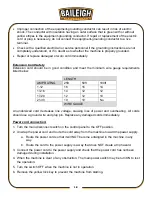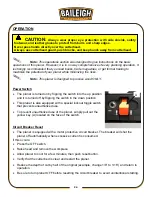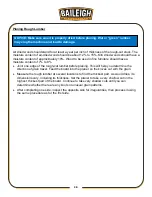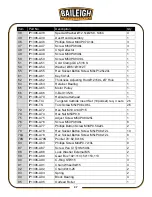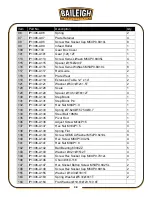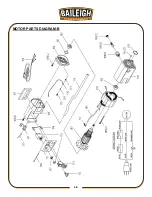
25
25
Getting Prepared
•
It is always a good idea to use a piece of scrap wood for your first planing attempt.
•
Before each use of the planer, make it a habit of checking for loose fasteners, fittings or
hardware.
•
Turn the planer ON and allow it to reach full speed. Pay close attention to any excessively
loud noises that may be coming from the planer or any excessive vibration. If either occurs,
shut down the planer immediately checking again for loose hardware.
Basic Operation
1. Put on safety glasses and a respirator, and secure loose clothing and long hair.
2. Set the depth of cut to the desired setting.
3. Stand to either the left or right side of the planer.
4. Flip the switch to the ON position.
5. Lift the workpiece onto the infeed table by grabbing the edges of the board at the middle of
the length.
Note: For longer pieces, be sure to use additional supports or stands.
6. Push slightly on the board to start feed and allow the feed rollers to pull the board through
the planer. Once the feed rollers start to pull the workpiece through, let go of the board and
allow the rollers to do their job.
DO NOT
push or pull on the workpiece once the rollers have
engaged.
7. Move to one side of the rear of the planer and receive the planed workpiece by grabbing the
edges of the wood like you did when feeding the workpiece in.
8. It normally takes several passes of varying depths to achieve a smooth finish, so repeat this
process as many times as necessary. Remember the less you take off in a pass, the
smoother the finish will be, but you may still need to finish the surface by sanding.
WARNING:
DO NOT stand or allow anyone else to stand directly behind
infeed table while feeding material. DO NOT bend down to see how stock is feeding.
Should a kickback occur, serious or fatal injury could result.
Summary of Contents for IP-1306
Page 38: ...35 35 PLANER PARTS DIAGRAM A...
Page 43: ...40 40 MOTOR PARTS DIAGRAM B...
Page 47: ...44 44 NOTES...








